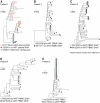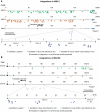HIV latency. Specific HIV integration sites are linked to clonal expansion and persistence of infected cells
- PMID: 24968937
- PMCID: PMC4262401
- DOI: 10.1126/science.1254194
HIV latency. Specific HIV integration sites are linked to clonal expansion and persistence of infected cells
Abstract
The persistence of HIV-infected cells in individuals on suppressive combination antiretroviral therapy (cART) presents a major barrier for curing HIV infections. HIV integrates its DNA into many sites in the host genome; we identified 2410 integration sites in peripheral blood lymphocytes of five infected individuals on cART. About 40% of the integrations were in clonally expanded cells. Approximately 50% of the infected cells in one patient were from a single clone, and some clones persisted for many years. There were multiple independent integrations in several genes, including MKL2 and BACH2; many of these integrations were in clonally expanded cells. Our findings show that HIV integration sites can play a critical role in expansion and persistence of HIV-infected cells.
Copyright © 2014, American Association for the Advancement of Science.
Figures



Comment in
-
HIV/AIDS. Persistence by proliferation?Science. 2014 Jul 11;345(6193):143-4. doi: 10.1126/science.1257426. Science. 2014. PMID: 25013050 No abstract available.
References
-
- Deeks SG, Autran B, Berkhout B, Benkirane M, Cairns S, Chomont N, Chun T-W, Churchill M, Di Mascio M, Katlama C, Lafeuillade A, Landay A, Lederman M, Lewin SR, Maldarelli F, Margolis D, Markowitz M, Martinez-Picado J, Mullins JI, Mellors J, Moreno S, O’Doherty U, Palmer S, Penicaud MC, Peterlin M, Poli G, Routy JP, Rouzioux C, Silvestri G, Stevenson M, Telenti A, Van Lint C, Verdin E, Woolfrey A, Zaia J, Barré-Sinoussi F, International AIDS Society Scientific Working Group on HIV Cure Towards an HIV cure: A global scientific strategy. Nat. Rev. Immunol. 2012;12:607–614. Medline doi:10.1038/nri3262. - PMC - PubMed
-
- Palmer S, Josefsson L, Coffin JM. HIV reservoirs and the possibility of a cure for HIV infection. J. Intern. Med. 2011;270:550–560. Medline doi:10.1111/j.1365-2796.2011.02457.x. - PubMed
-
- Bailey JR, Sedaghat AR, Kieffer T, Brennan T, Lee PK, Wind-Rotolo M, Haggerty CM, Kamireddi AR, Liu Y, Lee J, Persaud D, Gallant JE, Cofrancesco J, Jr., Quinn TC, Wilke CO, Ray SC, Siliciano JD, Nettles RE, Siliciano RF. Residual human immunodeficiency virus type 1 viremia in some patients on antiretroviral therapy is dominated by a small number of invariant clones rarely found in circulating CD4+ T cells. J. Virol. 2006;80:6441–6457. Medline doi:10.1128/JVI.00591-06. - PMC - PubMed
-
- Kearney MF, Spindler J, Shao W, Yu S, Anderson EM, O’Shea A, Rehm C, Poethke C, Kovacs N, Mellors JW, Coffin JM, Maldarelli F. Lack of detectable HIV-1 molecular evolution during suppressive antiretroviral therapy. PLOS Pathog. 2014;10:e1004010. Medline doi:10.1371/journal.ppat.1004010. - PMC - PubMed
Publication types
MeSH terms
Substances
Grants and funding
LinkOut - more resources
Full Text Sources
Other Literature Sources
Medical
Molecular Biology Databases

